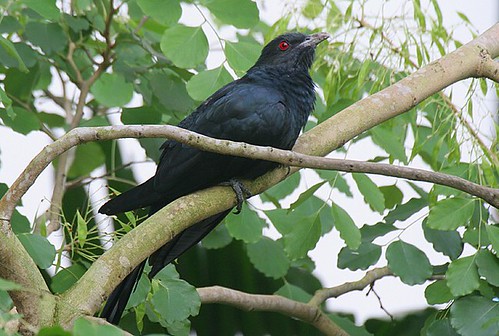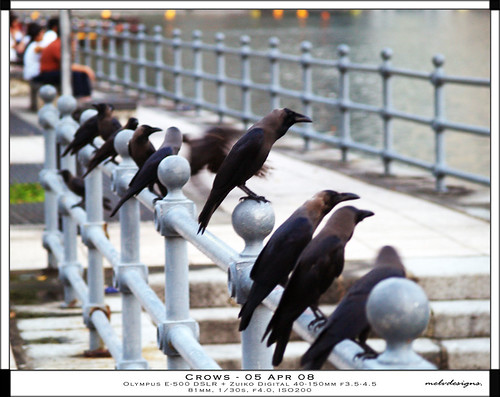
Male Asian koel (Eudynamys scolopaceus), Bukit Panjang;
(Photo by kampang)
The Asian koel is a bird that has adapted very well to urban Singapore. Not everyone knows its name, nor is it often spotted, but I'm sure that everyone in Singapore would be familiar with the male's unmistakable call.
This is an audio recording of a male Asian koel in the Singapore Botanic Gardens.
(Taken from xeno-canto Asia)
While most people appear to be tolerant of the koel's loud and often repetitive calls, it has been known to raise the ire of some people, and one resident in Pasir Ris did write in to the press to complain about being disturbed in the early morning. A 2002 article in the Straits Times cited a few more examples of how the koel has affected residents, but also mentioned how some people have come to tolerate or even appreciate the koel's calls. Personally, I think there are far more irritating noises that disturb my sleep, and they are all generated by human activity.
Loud birdsong is disturbing my sleep (The New Paper) (2nd October 2007)
A morning koel from the wild (Straits Times) (15th December 2002)
Marcus has written about the Asian koel over at this post, while Hen has done so over here.
The female actually looks quite different from her mate; while he is a glossy bluish-black, she is brown with white spots and streaks. Both sexes however share the characteristic bright red eyes.


A pair of Asian koels spotted at Bukit Panjang.
Left: Male Asian koel;
Right: Female Asian koel;
(Photos by kampang)
Predominantly frugivorous, the Asian koel swallows small fruits whole and regurgitates the seeds. There are several posts over at the Bird Ecology Study Group describing the Asian koel's feeding behaviour; examples include this post documenting the koel feeding on Indian cherry (Muntingia calabura) and Alexandra palm (Archontophoenix alexandrae), as well as this post showing the koel in the process of regurgitating a seed.
The Asian koel is currently found throughout Singapore, in all habitats except for primary and mature secondary rainforest. But it was not always so common. Up until the late 1980s, the Asian koel was actually considered to be a non-breeding visitor. In fact, A Guide to the Common Birds of Singapore lists the species as a winter visitor. What led it to become such a common and widespread resident?
The story of how the Asian koel became one of Singapore's most common birds is actually closely linked to that of another bird species, the house crow (Corvus splendens), which is a non-native species that first appeared locally in the mid-1940s.

House crows, Singapore River;
(Photo by melvdesigns)
You see, the Asian koel is actually a member of the cuckoo family, and one famous trait of many cuckoo species is that they are brood parasites. What happens is that these cuckoos make use of other species of bird to raise their young. This video clip explains it all:
The female cuckoo finds the unguarded nest of a suitable host bird; some cuckoo species specialise on one particular species, while others may parasitise a variety of species. For the Asian koel, the preferred host in Singapore is the house crow, although the large-billed crow (Corvus macrorhynchos) is another important host species elsewhere in its range. The Asian koel is also known to target slender-billed crow (Corvus enca), Flores crow (Corvus florensis), red-billed blue magpie (Urocissa erythrorhyncha), black-naped oriole (Oriolus chinensis), black-hooded oriole (Oriolus xanthornus), black drongo (Dicrurus macrocercus), hill myna (Gracula religiosa) and even common myna (Acridotheres tristis) and white-vented myna (Acridotheres grandis) in other parts of Asia. In some species, the cuckoo's egg even closely resembles the eggs of the host, thus furthering the deception.
When the chick hatches, the unwitting foster parent will feed the baby cuckoo as if it was its own young. The cuckoo nestling may actually get rid of the competition by pushing the eggs and hatchlings of its foster parent out of the nest, while in other species, the young cuckoo grows up alongside the chicks of its host.
Even so, the cuckoo's foster siblings don't necessarily survive, due to increased competition for food from the cuckoo; the cuckoo chick is usually larger and louder than its competition, and it constantly begs for food, leading the foster parent to devote all its time to feeding the cuckoo while neglecting its own young. The cuckoo quickly puts on weight, outgrowing any surviving competitors. In some species, the cuckoo grows even bigger than its foster parent! One can often find images of a young common cuckoo (Cuculus canorus) dwarfing the adult Eurasian reed warbler (Acrocephalus scirpaceus) that is busy cramming food into its bill.

Here's an example I found from Wikipedia.
The Asian koel is quite similar to its European relative, but with some differences. This cuckoo actually works as a team; the male distracts the crow guarding the nest, encouraging the crow to attack and pursue him, which leaves the nest unattended and ready for the female to deposit her egg. Sometimes, she will remove one of the crow's eggs while laying her own egg in the nest. Only when the female is done will she give a characteristic call and the pair will depart the scene. Also, the koel chick does not always kill its foster siblings, but nonetheless, it still imposes a heavy toll on the reproductive success of the crow.
And so, the house crow's spread in urban Singapore has encouraged its brood parasite, the formerly uncommon Asian koel, to establish itself as a resident breeder in Singapore. The number of koel swell in the months between September and April, when the resident breeding population is joined by visitors from the north, possible from as far as southern China and Hong Kong. No doubt, it is likely that the koel now provides some contribution in controlling crow numbers.
The Bird Ecology Study Group has an excellent variety of older posts on the Asian koel and its reproductive behaviour. It appears that there is still a lot we have yet to discover about this interesting relationship between the koel and the house crow.
Does Asian Koel eject House Crow's eggs?
Asian Koel: First recorded begging-call mimicry
Egg-dumping by Asian Koels
Tang's nesting crows 1: Whose eggs are these?
Tang's nesting crows 2: Yes, whose eggs were those?
Tang's nesting crows 3: The destruction of the nest and the end of the saga
Angie's nesting crows - 1. A nest in the making
Angie's nesting crows 2: Attack by the koels
Angie's nesting crows 3: Who dropped these eggs?
Angie's crows 4: Is this the end of the crow-koel saga?
Angie's nesting crows 5: Final chapter
There's also quite a few posts on brood parasitism in other local cuckoo species, including the rusty-breasted cuckoo (Cacomantis sepulcralis), banded bay cuckoo (Cacomantis sonneratii), little bronze cuckoo (Chrysococcyx minutillus), and drongo cuckoo (Surniculus lugubris).
I could talk a bit more about the house crow itself, but that is best reserved for another post.